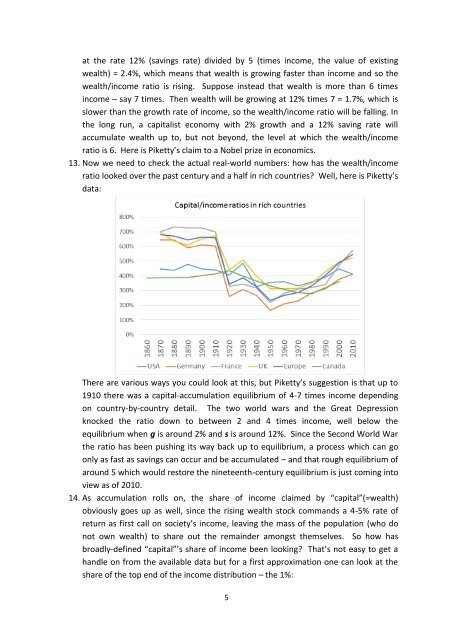Piketty for dummies
Piketty for dummies
Piketty for dummies
- No tags were found...
You also want an ePaper? Increase the reach of your titles
YUMPU automatically turns print PDFs into web optimized ePapers that Google loves.
at the rate 12% (savings rate) divided by 5 (times income, the value of existingwealth) = 2.4%, which means that wealth is growing faster than income and so thewealth/income ratio is rising. Suppose instead that wealth is more than 6 timesincome – say 7 times. Then wealth will be growing at 12% times 7 = 1.7%, which isslower than the growth rate of income, so the wealth/income ratio will be falling. Inthe long run, a capitalist economy with 2% growth and a 12% saving rate willaccumulate wealth up to, but not beyond, the level at which the wealth/incomeratio is 6. Here is <strong>Piketty</strong>’s claim to a Nobel prize in economics.13. Now we need to check the actual real-world numbers: how has the wealth/incomeratio looked over the past century and a half in rich countries? Well, here is <strong>Piketty</strong>’sdata:There are various ways you could look at this, but <strong>Piketty</strong>’s suggestion is that up to1910 there was a capital-accumulation equilibrium of 4-7 times income dependingon country-by-country detail. The two world wars and the Great Depressionknocked the ratio down to between 2 and 4 times income, well below theequilibrium when g is around 2% and s is around 12%. Since the Second World Warthe ratio has been pushing its way back up to equilibrium, a process which can goonly as fast as savings can occur and be accumulated – and that rough equilibrium ofaround 5 which would restore the nineteenth-century equilibrium is just coming intoview as of 2010.14. As accumulation rolls on, the share of income claimed by “capital”(=wealth)obviously goes up as well, since the rising wealth stock commands a 4-5% rate ofreturn as first call on society’s income, leaving the mass of the population (who donot own wealth) to share out the remainder amongst themselves. So how hasbroadly-defined “capital”’s share of income been looking? That’s not easy to get ahandle on from the available data but <strong>for</strong> a first approximation one can look at theshare of the top end of the income distribution – the 1%:5


